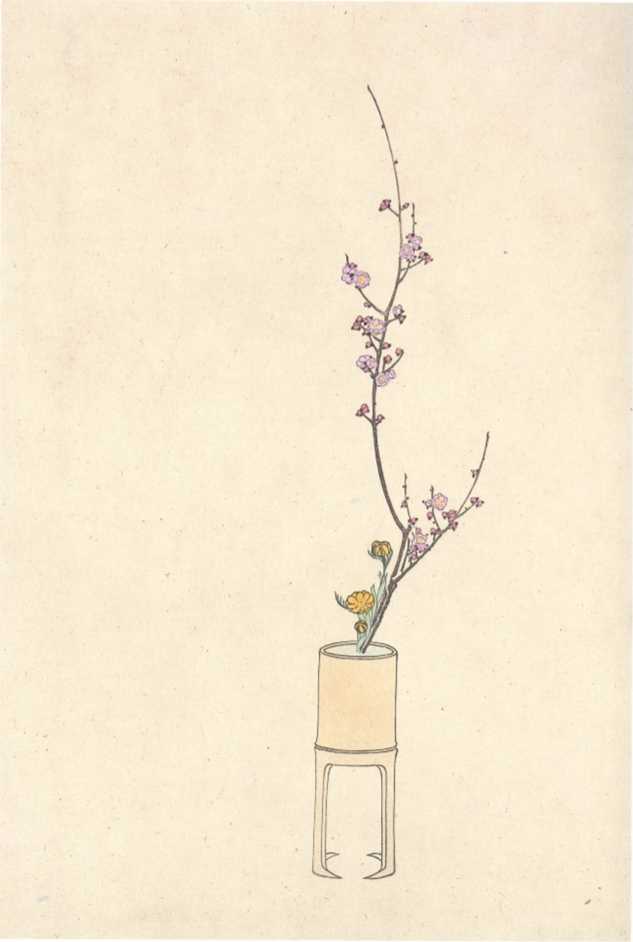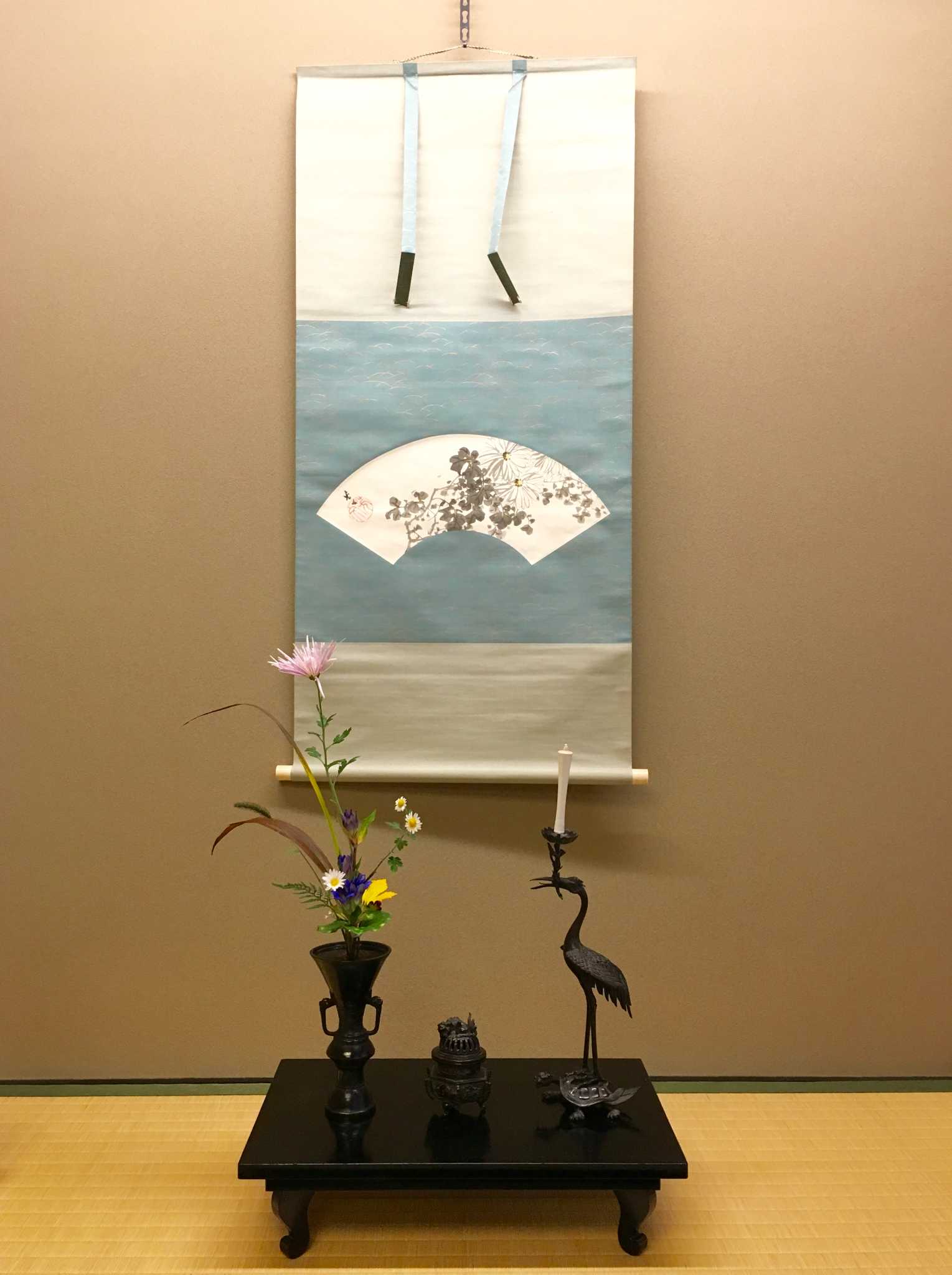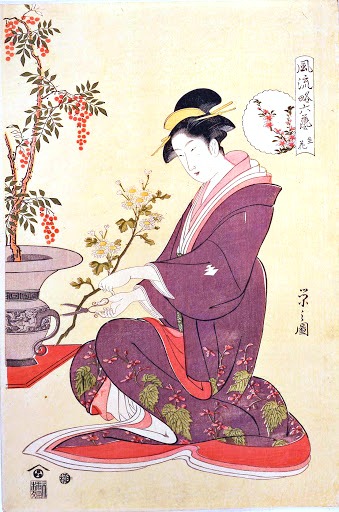Ikebana (生け花) ist die japanische Kunst des Blumenarrangierens. Übersetzt bedeutet es «lebende Blumen». Die meditative Form des Ikebana wird Kadō (華道 «Weg der Blumen») genannt. Sowohl Schüler als auch Lehrer des Kadō werden Kadōka (華道家) genannt.
Im Ikebana werden Blumen und Zweige in Schalen oder Vasen arrangiert. Ikebana ist jedoch nicht nur das Einstellen von Blumen, es bedeutet mehr:
* betrachten lernen
* zur Ruhe kommen
* sich an der Schönheit der Natur freuen
* sich Zeit nehmen ein lebendes Kunstwerk zu schaffen
* immer wieder Neues zu gestalten
* sich weiter entwickeln
* internationale Freundschaft durch Blumen zu pflegen
Ein Ikebana-Arrangement ist ein der Natur nachempfundenes Werk. Mit den feinen Linien sich schaukelnder Gräser, einem knorrigen Föhrenzweig oder einer aufblühenden Lilie können wir die Vielfalt darstellen, der wir täglich in der Natur begegnen. Es braucht nicht viel, keinen ganzen Baum, um die Zartheit der Kirschblüten zu zeigen – ein Zweig genügt. Wird diesem Zweig, den Blättern und Blüten genügend Raum gegeben, können sie ihre ganze Schönheit und Eigenart entfalten. Sie alle sollen in einem Ikebana-Arrangement zu einem harmonischen Werk arrangiert werden.
Die Harmonie ist die Seele eines Arrangements, das Ruhe ausstrahlt und zum Betrachten anregt. Das natürliche Werden kommt ebenso zum Ausdruck wie das Vergehen. Ikebana ist ein Weg. Ewig bleibendes ist der japanischen Blumenkunst fremd, denn die Natur und das Leben sind ständigem Wandel unterworfen.
Ikebana entwickelt sich immer weiter. Moderne, zum Teil sehr abstrakte Arrangement haben ihren Platz genauso wie traditionelle Formen, die seit über tausend Jahren den Betrachter zum Staunen bringen. Die verschiedenen Schulen pflegen unterschiedliche Stilrichtungen, jedoch sind die Grundlagen des Ikebana überall dieselben.
Geschichte
Die Bewunderung schöner, natürlich blühender Blumen ist im Osten und Westen seit der Antike allgegenwärtig. Zusätzlich zum Betrachten können wir die Spiritualität der Blumen und Bäume selbst spüren und sie als Symbol des Göttlichen, oder Yorishiro (依り代) im Shintoismus genannt, verstehen. Im Buddhismus wird der Bereich vor der Abbildung des Buddhas mit bunten Blumen geschmückt, um die Welt des Reinen Landes nachzubilden. Später bestanden die Opfergaben aus Blumen, Räucherwerk und Kerzen, bekannt als Mitsu-Gusoku (三具足). Die Ursprünge des Entstehens von Ikebana begannen in der Ehrfurcht vor der Natur im Shintoismus und der Blumengabe im Buddhismus.
Während der Heian-Zeit (784-1185) drehte sich eine Vielzahl von freizeitlicher Gestaltung um das beliebte Interesse an Blumen und Pflanzen, einschließlich botanischer Spiele und Wettbewerbe, die von lokalen Kreisen und Gruppen organisiert wurden. Diese Veranstaltungen wurden normalerweise als Hana awase (花合わせ) bezeichnet bei dem die Spieler um die Identifizierung und Zuordnung von Blumenarten entweder mit einem Gedicht oder mit einer bestimmten Jahreszeit konkurrierten. Andere beliebte Spiele entwickelten sich später als Variationen von Hana awase.
In der Muromachi-Zeit wurde das Hana gyokai (花御会) in den Residenzen einflussreicher Adelsfamilien in Kyoto veranstaltet. Das Hana gyokai ist eine Fortsetzung des Hana awase, der seit der Heian-Zeit abgehalten wird. Nachdem das Hana gyokai auch mit der buddhistischen Veranstaltung Shisseki Houraku (七夕法楽) verbunden wurde, wurde das Hana gyokai ein reguläres Fest auch im Haus des Shōgun während der Muromachi-Zeit. In Schriftstücken wie zum Beispiel Tagebücher von Beamten und Mönchen wurde über dieses Fest geschrieben.
Das Tatehana (立花 "stehende Blumen") des Mitsu-Gusoku war die früheste Form von Blumenarrangements. Zusätzlich wurden die Dekorationen basierend auf den buddhistischen Blumenangaben als Dekorationen für Waka und Renga Gedichtsitzungen arrangiert. Der Dōbōshū (同朋衆) war ein Amt bzw. ein Titel einer Person, welche im Shōgun-Palast für die Innendekoration wie Blumen, Teezeremonie, usw. zuständig war. Der Mönch Ikenobō Senkei aus dem Rokkaku-dō hatte sich auf Blumen spezialisiert und sammelte und verfasste Schriften zum Thema. Die Blumen, die ursprünglich Opfergaben und dekorative Elemente des Altars waren, wurden mit der Zeit als selbständige Kunstwerke geschätzt und anerkannt. Sowohl das Amt des Dōbōshū als auch der Mönch Ikenobō Senkei wurden erstmals in der Muromachi-Periode erwähnt.
Als die turbulente Zeit der Sengoku-Zeit (1477-1573) zu Ende ging und Toyotomi Hideyoshi (1537-1598) das Reich vereinte, erschien Rikka (立花) als zeremonielle Dekoration in den Residenzen der Samurai. Rikka entwickelte sich aus dem Tatehana. Die Arrangements wurden groß und luxuriös, weil sie den Empfangsraum der Residenzen und die Daishoin-Halle (大書院) einer Daimyō-Residenz schmückten. An den Höfen von Kyoto wurde häufig im inneren Palast (内裏 Dairi), im Sentō-Palast (仙洞御所) und in offiziellen Residenzen Rikka mit prächtigen Blumen aufgestellt, die für die gesellschaftliche Zusammenkunft von Menschen der gehobenen Kultur geeignet waren. Als das Tokugawa-Shogunat im frühen 17. Jahrhundert gegründet wurde, trat während der Herrschaft von Kaiser Go-Mizunoo und Kaiserin Meishō in der Kan'ei-Ära (1624-1644) ein neuer Trend in der Ästhetik auf. Bekannt als Kan'ei-Kultur (寛永文化), wurde in dieser Zeit die Bedeutung von Eleganz in der Schönheit hervorgehoben und konzentrierte sich auf Schlichtheit, feiner Gestaltung und eine Wiederbelebung und Ehrfurcht vor traditionellen Ritualen, antiker Kunst und klassischer Literatur. Diese „Essenz der Eleganz“ blühte am kaiserlichen Hof auf und wuchs an Bedeutung durch Werke von Künstlern und Aristokraten. Im Bereich des Blumenarrangierens erhielt Ikenobō Senko die Unterstützung des Kaisers. In der frühen Edo-Zeit erreichte die Kan'ei-Kultur ihre Blütezeit, an der fast alle Gesellschaftsschichten von Aristokraten und Samurai-Familien bis hin zu Mönchen und Stadtbewohnern beteiligt waren.
In den aufstrebenden Metropolen Osaka und Edo, heute Tokio, entwickelten sich neue Schulstile. Blumenarrangieren verbreitete sich durch die gesellschaftliche Struktur, von der Aristokratie und der Samurai-Kriegerklasse bis zu den Stadtbewohnern und wohlhabenden Bauern.
Während luxuriöse Rikka in den repräsentativen Räumen von Villen und Tempeln präsentiert wurden, gewannen in den Räumen gewöhnlicher Machiya-Häuser einfaches und schlichteres Nageirebana (抛入れ花) und Seika (生花) an Popularität. Eine große Anzahl von Schriften mit Bildern wurden veröffentlicht und Ikebana erlebte einen rasanten Aufschwung und Verbreitung.
Die Meiji-Restauration ab 1868 brachte große Veränderungen und Verwirrung in der japanischen Gesellschaft mit sich. Modernisierer betrachteten Teile der traditionellen Kultur als veraltet und priesen die westliche Kultur. So wie neue westliche Einflüsse nach Japan kamen, wurde umgekehrt im Westen die traditionelle japanische Kultur bekannter. Ikebana wurde weltweit als japanischer Kulturwert verbreitet. Moribana (盛花) entwickelte sich in dieser Zeit und wurde beliebt. Ikebana wurde aktiv in den Schulunterricht für Mädchen einbezogen. Mit der Modernisierung von Kunst veränderte sich auch Ikebana und avantgardistische Werke entstanden. Auf vielfältige Weise, von traditionellen Stilwerken bis hin zu modernen Werken im freien Stil, entwickelte sich das neuzeitige Ikebana und avantgardistische Werke entstanden.
Heute existieren tausende von Schulen mit Millionen von Menschen die Ikebana praktizieren, in Japan und auf der ganzen Welt.

Zeichnung eines Shōka aus Kirschzweigen in einer Bambusvase, vom Iemoto Ikenobō Senjō. Illustration aus dem Sōka Hyakki (挿花 百規) von 1820

Tatehana-Blumenarrangement als Teil des Mitsu-gusoku in einer Nische vor einem Rollbild

Ukiyo-e Holzdruck einer verheirateten Frau beim Ikebana (Edo-Zeit, 18. Jahrhundert, von Chōbunsai Eishi)
Gefässe
Wenn Blumen in einen Raum gebracht werden und diese bewundert werden sollen, wird ein Behälter benötigt in dem diese aufbewahrt werden können, z. B. Gefässe, Schalen, Vasen, Zylinder oder Körbe. Bereits vor der Etablierung des Ikebana wurden Vasen im chinesischen Stil, wie kostbare und seltene Bronze- und Seladonwerke, hochgeschätzt. Dies veränderte sich im Laufe der Jahrhunderte und Gefässe aus schlichter und erdiger Keramik mit der imperfekt-anmutenden Oberfläche aus japanischer Herstellung wurden beliebter. Dieser japanische Stil ergänzte durch seinen Kontrast zu glatter und symmetrischer chinesischer Keramik die Auswahl. Auch im Bereich der Bambuskörbe gibt es Objekte im chinesischen wie im japanischen Stil.
Im Ikebana ist es wichtig, die Blumen nicht nur auszuwählen, sondern auch mit den passenden Gefässen zu kombinieren. Vasen werden je nach der Art wie zum Beispiel das Rikka, Seika oder Chabana ausgewählt. Es ist das Ziel die perfekte Harmonie von Blumen und Gefässen zu erreichen und ein Gesamtkunstwerk der ausgewogenen Ästhetik zu erschaffen. Hierbei spielt das Konzept von Ma (間) eine wichtige Rolle.
Stile
Es gibt verschiedene Hauptstile:
- Rikka
- Nageire / Heika
- Seika / Shoka
- Bunjinbana / Bunjinka
- Moribana
- Jiyubana / Jiyuka
Literatur
-
Fujiwara, Yuchiku: Rikka – Klassische Form japanischer Blumenkunst. Ulmer, Stuttgart 1985, ISBN 3-8001-6120-6
-
Graefe, Ayako: Ikebana: Geist und Schönheit japanischer Blumenkunst. BoD GmbH, Norderstedt, 2010. ISBN 978-3839140345
-
Herrigel, Gusty L.: Zen in der Kunst des Blumen-Weges. O. W. Barth im Scherz-Verlag, Bern u.a. 2000, ISBN 3-502-67014-5
-
Rother-Nakaya, Suzue. Ikebana : eine Einführung in die japanische Blumenkunst. AT Verlag, Aarau, 1995. ISBN 13: 9783855025053
-
Ohchi, Hiroshi: Ikebana - Die Kunst des Blumenarrangements in Japan. Niggli Verlag, Teufen, 1956, 1961
-
Sakagawa, Kikuto: Ikebana: Zen in der Kunst des Blumenweges. Umschau, 2006. ISBN 978-3865282606
-
Ikebana. Opposites Attract. Katrien Van Moerbeke (Hrsg.), Stichting Kunstboek, 2023. ISBN 978-9058566966
-
Masterclass Ikebana. Stichting Kunstboek, 2020. ISBN 978-9058566287
